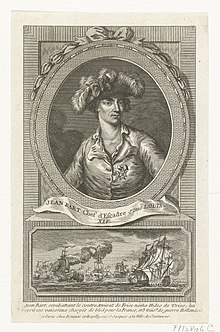Jean Bart
Jean Bart (French pronunciation: [ʒɑ̃ baʁ]; Dutch: Jan Baert; 21 October 1650 – 27 April 1702) was a Flemish naval commander and privateer.
His great-grandfather, Michel Jacobsen(fr) (1560-1632) distinguished himself in the service of the Spanish crown, bringing back the Invincible Armada after its failed attempt to invade England in 1588, and was appointed vice-admiral by Philip IV of Spain.
On one occasion, with six vessels, he broke through a blockading fleet, shattered a number of the enemy's ships and convoyed a transport of grain safely into Dunkirk harbor.
During the carnival of Dunkirk, held every year the Sunday before Holy Tuesday, local people kneel all together in front of his statue and sing the Cantate à Jean Bart[9][circular reference].
During the interwar period, in 1928, following excavations carried out in the church, Dr. Louis Lemaire found the bones of Jean Bart, which makes it possible to estimate his size, 1.90 m.[10]
In World War II, 70% of Dunkirk was destroyed, but the statue survived.More than 27 ships of the French Navy, over a period of 200 years, have borne the name Jean Bart.


